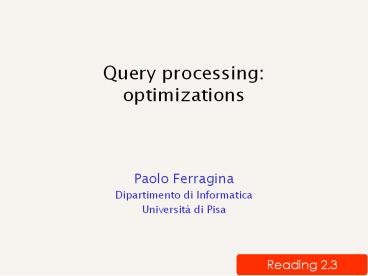Query processing: optimizations - PowerPoint PPT Presentation
Title:
Query processing: optimizations
Description:
Title: Web Algorithmics Author: Paolo Ferragina Last modified by: Paolo Ferragina Created Date: 9/18/2002 4:13:07 PM Document presentation format – PowerPoint PPT presentation
Number of Views:33
Avg rating:3.0/5.0
Title: Query processing: optimizations
1
Query processingoptimizations
- Paolo Ferragina
- Dipartimento di Informatica
- Università di Pisa
Reading 2.3
2
Augment postings with skip pointers (at indexing
time)
Sec. 2.3
128
41
31
11
31
- How do we deploy them ?
- Where do we place them ?
3
Using skips
Sec. 2.3
128
41
128
31
11
31
Suppose weve stepped through the lists until we
process 8 on each list. We match it and advance.
We then have 41 and 11 on the lower. 11 is
smaller.
4
Placing skips
Sec. 2.3
- Tradeoff
- More skips ? shorter spans ? more likely to skip.
But lots of comparisons to skip pointers. - Fewer skips ? longer spans ? few successful
skips. Less pointer comparisons.
5
Placing skips
Sec. 2.3
- Simple heuristic for postings of length L
- use ?L evenly-spaced skip pointers.
- This ignores the distribution of query terms.
- Easy if the index is relatively static.
- This definitely useful for in-memory index
- The I/O cost of loading a bigger list can
outweigh the gains!
6
Placing skips, contd
Sec. 2.3
You can solve it by Shortest Path
- What if it is known a distribution of access pk
to the k-th element of the inverted list? - w(i,j) sumki..j pk
- L0(i,j) average cost of accessing an item in
the sublist from i to j sumki..j pk (k-i1) - L1(1,n) 1 (first skip cmp) (cost to access
the two lists) - minugt1 w(1,u-1) L0(1,u-1) w(u,n)
L1(u,n) - L0(i,j) can be tabulated in O(n2) time
- Computing L1(i,n) takes O(n), given L1(j,n),
for jgti - Computing the total L1(1,n) takes O(n2) time
7
Placing skips, contd
Sec. 2.3
- What if it is also fixed the number of p
skip-pointers that can be allocated? - Same as before but we add the parameter p
- L1_p(1,n) 1 min_ugt1 w(1,u-1) L0(1,u-1)
- w(u,n) L1_p-1(u,n)
- L1_0(i,j) L0(i,j), i.e. no pointers left, so
scan - Li(j,n) takes O(n) time min calculation if are
available the values for Li-1(h,n) with h gt j - So Lp(1,n) takes O(pn2) time
8
Faster query caching?
- Two opposite approaches
- Cache the query results (exploits query
locality) - Cache pages of posting lists (exploits term
locality)
9
Query processingphrase queries and positional
indexes
- Paolo Ferragina
- Dipartimento di Informatica
- Università di Pisa
Reading 2.4
10
Phrase queries
Sec. 2.4
- Want to be able to answer queries such as
stanford university as a phrase - Thus the sentence I went at Stanford my
university is not a match.
11
Solution 1 Biword indexes
Sec. 2.4.1
- For example the text Friends, Romans,
Countrymen would generate the biwords - friends romans
- romans countrymen
- Each of these biwords is now an entry in the
dictionary - Two-word phrase query-processing is immediate.
12
Longer phrase queries
Sec. 2.4.1
- Longer phrases are processed by reducing them to
bi-word queries in AND - stanford university palo alto can be broken into
the Boolean query on biwords, such as - stanford university AND university palo AND palo
alto - Need the docs to verify
- They are combined with other solutions
Can have false positives! Index blows up
13
Solution 2 Positional indexes
Sec. 2.4.2
- In the postings, store for each term and document
the position(s) in which that term occurs - ltterm, number of docs containing term
- doc1 position1, position2
- doc2 position1, position2
- etc.gt
14
Processing a phrase query
Sec. 2.4.2
- to be or not to be.
- to
- 21,17,74,222,551 48,16,190,429,433
713,23,191 ... - be
- 117,19 417,191,291,430,434 514,19,101 ...
- Same general method for proximity searches
15
Query term proximity
Sec. 7.2.2
- Free text queries just a set of terms typed into
the query box common on the web - Users prefer docs in which query terms occur
within close proximity of each other - Would like scoring function to take this into
account how?
16
Positional index size
Sec. 2.4.2
- You can compress position values/offsets
- Nevertheless, a positional index expands postings
storage by a factor 2-4 in English - Nevertheless, a positional index is now commonly
used because of the power and usefulness of
phrase and proximity queries whether used
explicitly or implicitly in a ranking retrieval
system.
17
Combination schemes
Sec. 2.4.3
- BiWord Positional index is a profitable
combination - Biword is particularly useful for particular
phrases (Michael Jackson, Britney Spears) - More complicated mixing strategies do exist!
18
Soft-AND
Sec. 7.2.3
- E.g. query rising interest rates
- Run the query as a phrase query
- If ltK docs contain the phrase rising interest
rates, run the two phrase queries rising interest
and interest rates - If we still have ltK docs, run the vector space
query rising interest rates (see next) - Rank the matching docs (see next)































